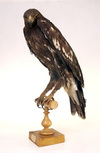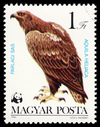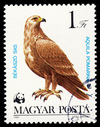Genus Aquila
Adalbert's Eagle - The Spanish Imperial Eagle is closely related to the Eastern Imperial Eagle . It occurs only in central and south-west Spain, Portugal and possibly northern Morocco. Formerly , the Spanish Imperial Eagle was considered to be a subspecies of the Eastern Imperial Eagle, but is now widely recognised as a separate species due to differences in morphology , ecology , and molecular characteristics .
Wedge-tailed Eagle - The Wedge-tailed Eagle is one of twelve species of large predominantly dark-coloured eagles in the genus Aquila found worldwide. A large brown bird of prey, it has a wingspan of up to 2.27 metres and a length up to 1.04 metres . Latest research indicates it forms a worldwide superspecies with Verreaux's Eagle, Gurney's Eagle and the Golden Eagle.
Golden Eagle - The Golden Eagle is one of the best known birds of prey in the Northern Hemisphere. Like all eagles, it belongs to the family Accipitridae. Once widespread across the Holarctic, it has disappeared from many of the more heavily populated areas. Despite being locally
Spotted Eagle - It is about 65 cm in length and has a wingspan of 160 cm. This medium-large eagle is very similar in general appearance to its closest relative the Lesser Spotted Eagle , which shares part of its range. Head and wing coverts are very dark brown and contrast with the generally medium brown plumage; the Lesser Spotted Eagle has a paler head and wing coverts. The head is small for an eagle. The similarites of the Greater Spotted to the Lesser Spotted often results in misidentification as being that species. This is further complicated by occasional hybrids between the two species.
Gurney's Eagle - This eagle is mainly dark brown to black, with paler undersides to its flight feathers and a rounded tail. Its body length is 74–86 cm; with a wingspan of between 1.7 and 1.9 m. Females are larger than males. Its wings are held level when gliding.
Aquila hastata - The Indian Spotted Eagle is about 60 cm in length and has a wingspan of 150 cm. It is broad-headed, with the widest mouth of all spotted eagles. This species has a lighter coloration overall compared to its relatives, with a darker iris that makes the eyes appear darker than the plumage . Adults can be told apart from the Greater Spotted Eagle by its lighter color, darker eyes, and habitat preferences . Juveniles, unlike the Lesser and Greater species, are not strongly spotted at all, making the common name somewhat misleading, and also lack the creamy buff nape patch of the juvenile Lesser Spotted Eagle.
Spanish Imperial Eagle - The Imperial Eagle, Aquila heliaca, is very similar to the Golden Eagle, but slightly smaller in body length and wingspan . Like all eagles, A. heliaca belongs to the bird of prey family Accipitridae.
Steppe Eagle - The Steppe Eagle, , is a bird of prey. It is about 62–81 cm in length and has a wingspan of 165–200 cm . Females, weighing 2.3-4.9 kg , are slightly larger than males, at 2-3.5 kg . Like all eagles, it belongs to the family Accipitridae. It was once considered to be closely related to the non-migratory Tawny Eagle, Aquila rapax, and the two forms have previously been treated as conspecific. They were split based on pronounced differences in morphology and anatomy ; two molecular studies, each based on a very small number of genes, indicate that the species are distinct but disagree over how closely related they are.
Lesser Spotted Eagle - This is a medium-sized eagle, about 60 cm in length and with a wingspan of 150 cm. Its head and wing coverts are pale brown and contrast with the generally dark plumage. The head and bill are small for an eagle. There is usually a white patch on the upperwings, and even adults retain a clear-marked white V on the rump; the wing markings are absent and the white V is not well-defined in the Greater Spotted Eagle.
Tawny Eagle - The Tawny Eagle is a large bird of prey. It is about 62–72 cm in length and has a wingspan of 165–185 cm and it weighs 1.6–2.4 kg. Like all eagles, it belongs to the family Accipitridae. It was once considered to be closely related to the migratory Steppe Eagle, Aquila nipalensis, and the two forms have previously been treated as conspecific. They were split based on pronounced differences in morphology and anatomy;.
Verreaux's Eagle - It is about 75 to 95 cm tall. The average weight for males is 3.7kg and for females is 4.5kg . It has a wingspan of up to 2.2 m . Juveniles are usually light and dark brown with a black face. Structurally, it is very similar to the Golden Eagle of the Northern Hemisphere, and the Wedge-tailed Eagle of Australia.
Wahlberg's Eagle - Wahlberg's Eagle breeds in most of Africa south of the Sahara. It is a bird of woodland, often near water. It builds a stick nest in the fork of a tree or the crown of a palm tree. The clutch is one or two eggs.









